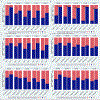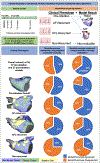Comparing Inducibility of Re-Entrant Arrhythmia in Patient-Specific Computational Models to Clinical Atrial Fibrillation Phenotypes
- PMID: 37656099
- PMCID: PMC10909381
- DOI: 10.1016/j.jacep.2023.06.015
Comparing Inducibility of Re-Entrant Arrhythmia in Patient-Specific Computational Models to Clinical Atrial Fibrillation Phenotypes
Abstract
Background: Computational models of fibrosis-mediated, re-entrant left atrial (LA) arrhythmia can identify possible substrate for persistent atrial fibrillation (AF) ablation. Contemporary models use a 1-size-fits-all approach to represent electrophysiological properties, limiting agreement between simulations and patient outcomes.
Objectives: The goal of this study was to test the hypothesis that conduction velocity (ϴ) modulation in persistent AF models can improve simulation agreement with clinical arrhythmias.
Methods: Patients with persistent AF (n = 37) underwent ablation and were followed up for ≥2 years to determine post-ablation outcomes: AF, atrial flutter (AFL), or no recurrence. Patient-specific LA models (n = 74) were constructed using pre-ablation and ≥90 days' post-ablation magnetic resonance imaging data. Simulated pacing gauged in silico arrhythmia inducibility due to AF-like rotors or AFL-like macro re-entrant tachycardias. A physiologically plausible range of ϴ values (±10 or 20% vs. baseline) was tested, and model/clinical agreement was assessed.
Results: Fifteen (41%) patients had a recurrence with AF and 6 (16%) with AFL. Arrhythmia was induced in 1,078 of 5,550 simulations. Using baseline ϴ, model/clinical agreement was 46% (34 of 74 models), improving to 65% (48 of 74) when any possible ϴ value was used (McNemar's test, P = 0.014). ϴ modulation improved model/clinical agreement in both pre-ablation and post-ablation models. Pre-ablation model/clinical agreement was significantly greater for patients with extensive LA fibrosis (>17.2%) and an elevated body mass index (>32.0 kg/m2).
Conclusions: Simulations in persistent AF models show a 41% relative improvement in model/clinical agreement when ϴ is modulated. Patient-specific calibration of ϴ values could improve model/clinical agreement and model usefulness, especially in patients with higher body mass index or LA fibrosis burden. This could ultimately facilitate better personalized modeling, with immediate clinical implications.
Keywords: MRI; atrial fibrillation; computational modeling; conduction velocity; fibrosis.
Copyright © 2023 American College of Cardiology Foundation. Published by Elsevier Inc. All rights reserved.
Conflict of interest statement
Funding Support and Author Disclosures This work was supported by a CADRe grant (John L. Locke Charitable Trust Fund), a Collaboration Innovation Award from the Institute of Translational Health Science grant (UL1 TR002319 National Center for Advancing Translational Sciences/National Institutes of Health), and National Institutes of Health grant R01 HL158667. Ms McDonagh is an employee of Biosense Webster, which owns CARTO/Coherent. All other authors have reported that they have no relationships relevant to the contents of this paper to disclose.
Figures





References
-
- Nattel S, Harada M. Atrial Remodeling and Atrial Fibrillation. Journal of the American College of Cardiology. 2014;63:2335–2345. - PubMed
-
- Marrouche NF, Wilber D, Hindricks G, et al. Association of Atrial Tissue Fibrosis Identified by Delayed Enhancement MRI and Atrial Fibrillation Catheter Ablation: The DECAAF Study. JAMA. 2014;311:498. - PubMed
-
- de Groot NMS, Shah D, Boyle PM, et al. Critical appraisal of technologies to assess electrical activity during atrial fibrillation: a position paper from the European Heart Rhythm Association and European Society of Cardiology Working Group on eCardiology in collaboration with the Heart Rhythm Society, Asia Pacific Heart Rhythm Society, Latin American Heart Rhythm Society and Computing in Cardiology. EP Europace. 2021:euab254. - PMC - PubMed
-
- Boyle PM, del Álamo JC, Akoum N. Fibrosis, atrial fibrillation and stroke: clinical updates and emerging mechanistic models. Heart. 2021;107:99–105. - PubMed
Publication types
MeSH terms
Grants and funding
LinkOut - more resources
Full Text Sources
Medical

